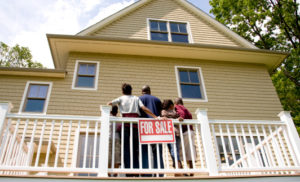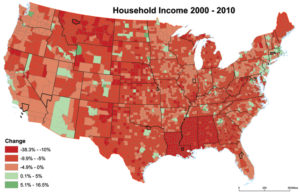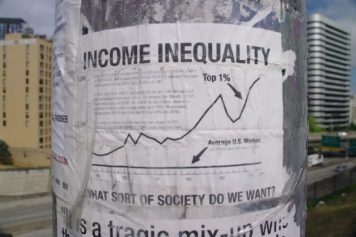
The reality is that being middle-class in America is a phrase that may soon need to be accompanied by air quotes or marked with an asterisk. Middle-class Americans remain stuck with stagnant incomes while the cost of living is on the rise, making their economic labels irrelevant when it comes to their quality of life.
The middle-class is a term that once evoked images of a comfortable family, perhaps in the suburbs. They don’t have an abundance of wealth but they have enough to make do. Some months may be harder than others in terms of finances but at the very least this family has a roof over their head, food on the table, clothes on their backs and can afford a reasonable amount of the luxuries life has to offer.
Recent research suggests that image of the middle-class is now outdated and inaccurate.
“In all 50 states, the percentage of ‘middle-class’ households—those making between 67 percent and 200 percent of the state’s median income—shrunk between 2000 and 2013,” the Pew Charitable Trust’s Stateline revealed.
America’s middle-class is no longer picking out family pets or affording a budget to redecorate their home.
Instead, they are struggling to simply make ends meet.
The Pew Charitable Trust’s research revealed that part of this change is coming from the lack of income increases amidst the evolution of a more expensive housing market.
“In most states, the growing percentage of households paying 30 percent (the federal standard for housing affordability) or more of their income on housing illustrates that it is increasingly difficult for many American families to make ends meet,” the analysis revealed.

Michigan Daily’s Jesse Klein composed a column about the shrinking middle-class, explaining that while her income would classify her as a middle-class American, she wasn’t living the luxurious life many would assume.
“My family’s household income is $250,000 a year, but I promise you I am middle class,” she wrote.
It’s a concept the drives that point of “relative wealth,” Klein explains.
While her family’s income seems like a lot to some, it meant nothing in the heart of a city where a nice one-story home would cost most San Jose, California residents more than $1 million.
Home prices are increasing, food costs are going up, health care is becoming less affordable, child care has become a luxury, even gas prices are embarking on a steady climb once again.
Household incomes, however, aren’t seeing major shifts and changes.
This means middle-class families are struggling to afford the simple, comfortable lifestyles to which they were once accustomed. The American Dream to many has become a mirage.


